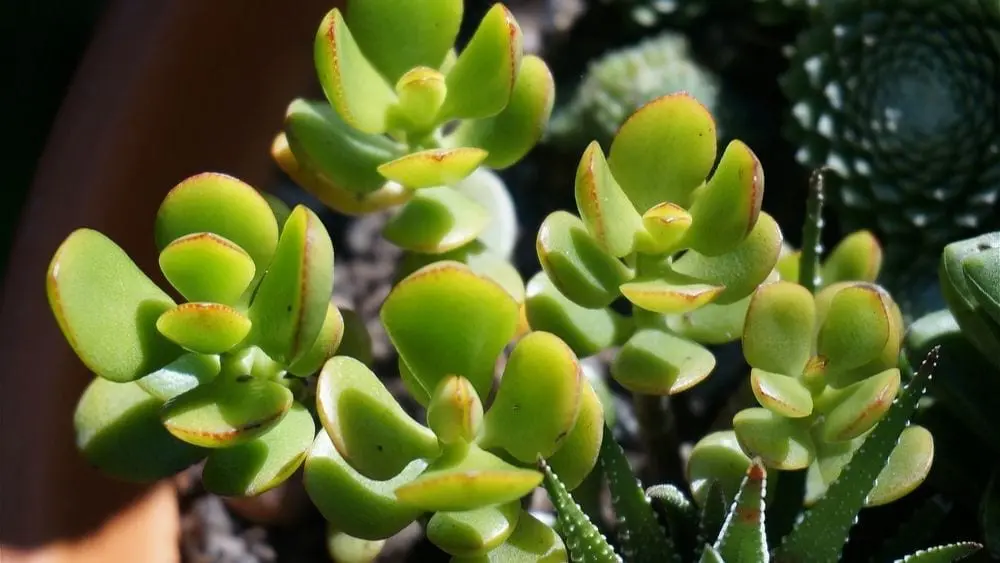
Plants are a wonderful way to make a house feel more homey
and cozy and alive, not to mention the physical benefits of having them around,
like cleaner air. While there are thousands of indoor plants to choose from,
we’ve selected a few unique houseplants that will stand out from the usual
pothos, snake plant, and peace lily crowd.
Pencil Cactus (Euphorbia tirucalli)
Despite its name, the Pencil Cactus is not a cactus. A member of the Euphorbia family – which includes succulents, poinsettias, and crown-of-thorns – this stunner turns beautiful shades of pink, orange, and yellow when grown in bright sun during cooler months. A perfect way to bring fall colors into your home! A small piece of advice: It’s recommended you wear gloves and exercise caution when caring for this plant as it can produce a sap when injured that is strongly irritating. This wildly branching plant needs a lot of light, low water, and soil that drains well (we recommend a cactus soil potting mix).
Jade Plant (Crassula ovata)
If you’re looking for a gift that keeps on giving, jades
are thick-leaved, glossy green succulents that live long enough to pass down
from generation to generation. They have trunks that make them look like small
trees, and they do best with a lot (4+ hours) of direct sunlight. They don’t
like to dry out as much as other succulents, so water as soon as the soil feels
dry to the touch, and keep in mind this plant is highly toxic for dogs and
cats.
Aralia Fabian (Polyscias scutellaria ‘Fabian’)
This unique-looking plant has a trunk that makes it
look like a little, columnar tree with round, flat leaves that have a purplish
underside. Somewhat similar in appearance to the larger Fiddle Leaf Fig (see
below), these two plants are nonetheless not
related. It grows three to four feet in height, likes a warm spot – never below
70°F – and several hours of direct sunlight from the south, east, or west. This
Aralia likes to dry out, and overwatering will cause problems. It’s toxic to
cats and dogs, so it’s a good idea to keep out of reach from furry friends, but
is also easily treated by a veterinarian.
Fiddle-Leaf Fig (Ficus lyrata)
The Fiddle Leaf Fig is one of the larger plants on our
list. It can grow up to six feet and has dramatic, large leaves and a tall,
sculptural form. It attracts many homeowners, and if you adopt one of these
majestic beauties it’s important to care for it properly. It prefers bright,
indirect light, and is sensitive to both under- and overwatering. Never water
more than once per week, and make sure the soil is dry one inch down before
watering again. Place the Fiddle Leaf Fig in a clear, plastic saucer and water
the soil until it pours out into the saucer. Make sure the water has fully
drained from the soil before returning it to its container. Quick tip: This is
another that causes stomach irritation if ingested by pets.
Prayer Plant (Maranta leuconeura)
The unique colors and patterns of the Prayer Plant
make it a beautiful and unique addition to any home. It is called a Prayer
Plant because every evening the tips of its leaves turn upward in a supplicant
position. These non-toxic plants have one peculiar requirement: they cannot
tolerate treated tap water. Either use tap water that has been sitting out for
at least 24 hours, or use rainwater.
Flamingo Lily (Anthurium)
There aren’t too many colorful plants that can withstand or even prefer low light conditions, but the Flamingo Lily is one of them! This is also one of the plants listed in the NASA Clean Air Study for removing formaldehyde, xylene, toluene, and ammonia from the air. Like its well-known relative the Peace Lily, Flamingo Lilies like humidity. If it isn’t in a location with extra moisture, place it on a tray of pebbles with a little bit of water to keep it humidified. Cats and dogs who ingest this plant will experience immediate symptoms, so they are unlikely to ingest enough to do serious harm.
Cotton Candy Fern (Nephrolepis exaltata ‘Smithii’)
This fluffy, appropriately-named fern has an
attractive bright green color and can reach 5 feet in length. It’s a fern, so
it will eventually drape down from a hanging basket (but can certainly be in a
smaller, tabletop container to start). It is easy to care for, as long as it is
getting plenty of bright, indirect light. It’s not as thirsty as some other
ferns, but it does appreciate consistent watering.
Twisted Lipstick Plant (Aeschynanthus ‘Rasta’)
This funky plant is so named because its flowers
resemble a tube of lipstick, and its draping stems and leaves resemble
dreadlocks. A hanging basket is ideal for this cascading plant. It prefers the
70 – 80°F range, and bright, indirect light. It needs slightly moist soil and does
enjoy some humidity, so mist it regularly.
Ponytail Palm (Beaucamea recurvata)
This sculptural plant is actually not a palm at all,
but more closely related to the Joshua Tree. In its native environment, it can
grow up to 30 feet, but indoors, will rarely grow above four feet tall. It
generally has one central stump and a cascade of long, green leaves that
resemble – wait for it – a ponytail! It likes a lot of light, but will tolerate
a range of conditions. It stores a lot of water in its trunk, so it prefers dry
soil. Let the top 1–2 inches get very dry before watering and make sure it
doesn’t stand in water. Water even less frequently in winter. This is a plant
that will thrive on benign neglect. It’s non-toxic to pets, which is probably
especially good for cats who might mistake this plant for a new toy!
Swiss Cheese Plant (Monstera deliciosa)
If you have empty space to fill in your home, this
plant is a perfect fit! The Swiss Cheese Plant has aerial roots growing down
from the stem, giving this plant a vine-like tendency. Its dramatic, large
leaves that resemble Swiss cheese (hence its common name) make quite a
statement, and overall it can grow to over 30 feet outdoors. When kept indoors,
its container will limit its size but you will still need to trim it back from
time to time. It prefers bright, indirect light, a temperature in the 68 – 86°F
range, and high humidity (so be sure to mist it regularly).
Chinese Money Plant (Pilea peperomioides)
Doesn’t looking at this plant make you smile? There’s
something about it that’s so peppy and fresh, and its floating disc leaves are
just too cute. It needs just a few things to thrive: bright and indirect light,
well-draining soil, not too much water (water when it looks a little droopy),
regular rotating (for balanced growth), and keep it away from any drafts or
temperature fluctuations. You can spot a happy Chinese Money Plant because they
propagate themselves when they are doing well.
Honestly,
this list could go on for days! There
are so many amazing plants out there, and scientists are still discovering new
ones and developing interesting crossbreeds. Whatever houseplants you choose to
bring into your home, figure out what they need to thrive so you and your
family can enjoy them for years to come. And if you choose a long-lived plant –
like the Jade Plant or Ponytail Palm mentioned above – you may even pass them
on to your children someday. What a special heirloom!
If
you’re still looking for the perfect place to call home, be sure to visit NewHomeSource for currently listings
all across the country!

For the last 16 years, Rachel Kinbar has been a writer of articles, blog posts, white papers, essays, infographics, web copy, sales copy, scripts, poetry, lyrics, and more. She has keen research skills that she applies to a wide variety of topics, and she especially loves topics related to design, history, and sustainable living.
 Home Style Guide: Courtyard Homes
Home Style Guide: Courtyard Homes